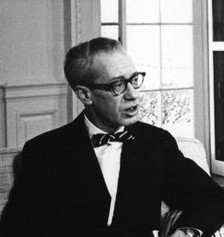
Photo info ...
Credit: Abbie Rowe, Public domain, via Wikimedia CommonsView Source
(Aug. 4, 1915-Jan. 3, 1987). Born in Hamilton, Ohio, John Bartlow Martin and his family came to Indianapolis when he was three years old. The eldest and only survivor of three brothers, Martin lived with his family in a house on Brookside Avenue. Although his family life was troubled (his parents would eventually divorce), Martin found comfort in books and decided at an early age he wanted to be a writer, despite his contractor father’s disapproval.
Expelled from DePauw University near the end of his first year for drinking, Martin worked as a night copyboy for the Indianapolis bureau of the Associated Press. He returned to DePauw in 1937, edited the school’s newspaper, and was a stringer for the . He accepted a full-time reporter’s position with the and completed his courses at DePauw in absentia. Starting on the police beat, Martin moved up to covering city hall for the newspaper. He eventually moved to Chicago and worked as a freelance writer producing articles for a number of true-crime magazines.
Over the years, Martin advanced to writing for such prestigious publications as , , , , and . Earning distinction as one of America’s best reporters, Martin returned to Indiana in 1946 to research a book on the state. Published in 1947, , although not bitter in tone, painted a less-than-flattering portrait of the state.
A lifelong liberal Democrat, Martin worked as a speechwriter for Adlai Stevenson’s losing presidential campaigns in 1952 and 1956. He had better luck in 1960 when he worked for John Kennedy’s successful run for the White House. Kennedy would later appoint Martin as ambassador to the Dominican Republic, a post he held until February 15, 1964.
Martin returned once again to Indiana in 1968 as an advisor to Robert Kennedy’s successful campaign in the state’s Democratic presidential primary. In 1969, he began teaching journalism at Northwestern University’s Medill School of Journalism, a post he held for 10 years.

Help improve this entry
Contribute information, offer corrections, suggest images.
You can also recommend new entries related to this topic.